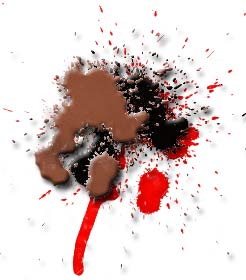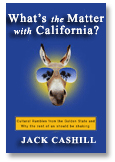Media Mum on Brown-on-Black Violence
WorldNetDaily.com
August 27, 2009
© Jack Cashill
I got a letter last week from Steven Nary, the sailor imprisoned in California these last 14 years for killing his would-be rapist.
Nary casually asked me what I thought about the massive flare-up in Chino.
The “riot,” as the media called it, injured 250 and caused millions of dollars in damages at the “California Institution for Men in Chino,” as the Department of Corrections and Rehabilitation insists on calling the prison.
Who came up with the name “the Department of Corrections and Rehabilitation” I do not know, but California is a state of euphemisms.
In fact, I had not thought anything of the incident because I had heard not a word about it. The news had not escaped California. I knew enough about the media, however, to suspect why so large a story had gone largely unreported.
And I was right. In the parlance of the California newspapers, the riot was “racially motivated.” In researching my book, What’s The Matter With California, I learned enough to guess what “racially motivated” means in a California context.
And I was right again. This took some digging. Some California media did not talk about the racial angle at all. Some left it at “racially motivated.”
The Los Angeles Times blog, to its credit, led with the racial angle but mangled the language in its attempt to be sensitive to all sides: “An overnight riot between African American and Latino inmates inside a Chino prison has been quelled.”
A “riot between?” The Times also reported that “a fire ignited during the chaos” as though that too were an act of Providence.
In the seventh paragraph of a Sacramento TV station blog I finally found someone willing to say what this “riot between” really meant.
"It appears we had some southern Hispanic gang members targeting African Americans," said a spokesman for the prison system. Oh, Okay.
Of course, had it been white gang members targeting African Americans this would have been a CNN Worldwide lead, but since blacks and browns are both presumed to be part of the larger liberal constituency, best to avoid the issue altogether.
Terry Anderson is the one media guy I met in California who chooses not to.
Anderson hosts a Sunday night radio program in Los Angeles that focuses on one subject: illegal immigration. When he started, the experts told him a one-subject show would never last. That was about ten years ago.
The day I met Anderson he had just come from a rally of African Americans against illegal immigration in South Central LA’s Leimert Park.
In attendance, in addition to Anderson, were the Black Minuteman and the Mothers Against Illegal Immigration. “The anger was unbelievable,” Anderson told me, and I did not doubt him.
As Anderson explained, blacks and browns tend to meet at the roughest edge of their respective colliding plates—the streets, the schools, and the prisons, and sometimes those edges blur.
To listen to Anderson and his callers, you get the sense that blacks feel like they are getting the raw end of the rub, especially now that there are five browns in the state for every one black.
Anderson has a theory that as soon as Hispanics outnumber blacks 60-40 in a given institution, violence soon follows.

Curiously, right after I met with Anderson, a riot broke out in the East Bay’s San Leandro High School. The ratio of Hispanics to blacks in the school proved almost exactly what Anderson had predicted.
“There are big fights between blacks and Mexicans at my high school every year,” wrote one student at San Leandro. “The reason I participated was because I know I have to get down with the black people because I'm black and that's just the rules.”
While I was visiting, a 100-student strong interracial melee erupted at LA’s Fremont High, once the legendary spawning ground of the Crips but now predominantly Hispanic.
Shortly afterwards, I finessed my way through security at Fremont—the LAUSD had ignored my requests for a tour—and took a walk through the controlled chaos of the school’s corridors.
One image sticks with me. It was of a bookish black girl, her head pulled into her shoulders like a turtle, walking meekly down the hall as two boys talk noisily in Spanish over the top of her.
Says one ex-con, “Lunchtime in the Los Angeles high schools has become something you can compare to yard release in the state prisons system.”
As volatile as the schools are, the prisons are the real flashpoint. Hispanics, many of them illegal immigrants, now outnumber blacks in the state prisons and county jails and tend to be better organized.
This power shift has led to chronic “brown-on-black” violence and numerous lockdowns throughout the state.
“What’s weird is [that] whites and blacks were separated by the racial issues of segregation and slavery,” Nary wrote from Pleasant Valley State Prison during one of the prison’s frequent lockdowns.
“However, it’s apparent in this state that Hispanics have a dislike towards blacks. Why? I am not sure.”
Black prisoners have had to ask the authorities for protection from their brown brothers. Prison flare-ups, often lethal, have become as common statewide as wild fires.
“It is often volatile to mix black and Hispanic inmates,” says the black ex-con referenced above. “There is bound to be a racial explosion.”
And yet our courts in their wisdom now insist that cell blocks be integrated. This mandate facilitated the assaults in Chino.
The ensuing melee caused millions of dollars in damage in a state that can’t afford it, a state that has morphed from envy of the world to third world in a generation.
And there is no way the state can even begin to morph back until the media face the facts, tell the truth and lose the euphemisms.


Get your autographed copy of Jack Cashill's book, "What's the Matter with California?"
